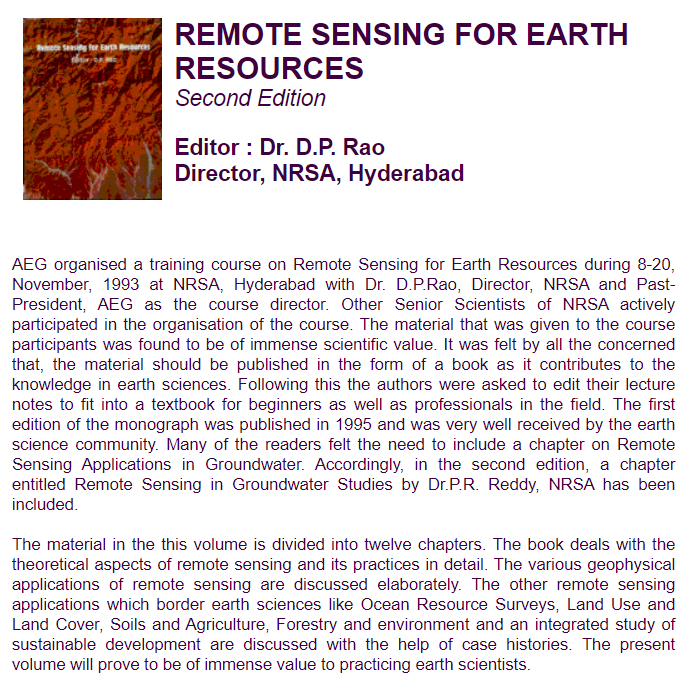
Year of Publication : 1999
AEG Publication No. 41
Number of Pages : 212
Book Size : 21cm x 27.5 cm
Price : Rs. 500 + 50* (in India)
US$ 50 + 5* (abroad)
* Postage and packing
Published by & Copies can be had from
Association of Exploration Geophysicists
12-13-157, Street No.2, Tarnaka
Hyderabad – 500 017, India
Ph : +91-040-701 4762, 27000 392; Telefax : +91-040-27171383
Email: aegind@yahoo.com
Web : www.aegind.org
CONTENTS
Chapter 1
ORBIT AND SUN-SYNCHRONOUS ASPECTS OF EARTH SATELLITES
Classification of Satellites; Terminology-Definitions; Mass-Gravitational Force Calculations; Sun-Synchronous Characteristics and life of the orbit; Repetivity and Swath Width
Chapter 2
PHYSICS OF REMOTE SENSING, ATMOSPHERIC EFFECTS AND REMOTE SENSING SENSORS
Electromagnetic Spectrum; Radiation Laws; Planck’s Law; Stefan-Boltzmann Law; Wien’s Displacement Law; Blackbody and Realbody Radiation; Atmospheric effects in Remote Sensing; Contrast and illumination effect on Human Vision; Interaction of Earth surface features with EMR ; Interaction of Visible, Near Infrared and Middle Infrared wavelengths with terrain features – conceptual aspects; Spectral characteristics of vegetation, water and soil; Interaction of thermal Infrared wavelengths with terrain features-conceptual aspects; Interaction of Microwaves with Earth’s surface; Remote Sensing Observation Platforms; Airborne Platforms; Space Based Platforms; Characteristics of Remote Sensors; Microwave Sensors; False Colour Composite
Chapter 3
MULTISPECTRAL SENSORS
Multispectral Remote Sensing; Multiband Cameras; Limitations of Cameras; Multiband Video Cameras; Constraints of Video Cameras; Opto-mechanical Scanners; Modular Multispectral Scanner; Characteristics of MSS; Constraints of Multispectral Scanners; Landsat Multispectral Scanner; Thematic Mapper; Linear Imaging Self Scanning Sensors (LISS)
Chapter 4
MICROWAVE REMOTE SENSING
Microwave Radiometers; Side looking Airborne Radar; Synthetic Aperture Radar; Wind Scatterometer; Radar Polarimetry; Radar Interferometry
Chapter 5
DIGITAL IMAGE PROCESSING
A) DIGITAL IMAGE PROCESSING TECHNIQUES:
Introduction to Digital Image processing; The Characteristics of Digital Images; Pixel Parameters; Image Processing Techniques Applied to Satellite Imagery; Image Reduction; Image Magnification; Image Enhancement; Contrast Enhancement; Ratioing; Principal Component Analysis (PCA); Filtering Techniques; Discrete Linear Operations; Spatial Smoothing Operators; Spatial Sharpening Operators; Edge Detection; Edge Detection – Operators; Directional Filters; Frequency Domain Filtering; Classification/Pattern Recognition; Supervised Classification; Training site selection and extraction of statistics; Classification Algorithms
B) DIGITAL IMAGE PROCESSING SYSTEMS:
Configuration of digital analysis system : hardware and software; Image processing system characteristics; Number of analysts and mode of operation; Centre processing unit, arithmetic co-processor and random access memory; Operating system and compiler; Mass storage; Display resolution; Colour resolution; Software
Chapter 6
GEOLOGICAL APPLICATIONS
Fundamentals of geological-image interpretation; Image Elements; Terrain Elements; Collateral Data; Remote Sensing for Lithological Discrimination and Geological Mapping; Spectral signature of rocks; Interpretation process; Significance of drainage analysis; Criteria for lithologic discrimination; Sedimentary Rocks; Metamorphic Rocks; Criteria for structural mapping; Use of thermal infrared and microwave data in geological mapping; Case study; cope of research in future; Application of Thermal Remote Sensing in Geology; Basic Concepts; Thermal Properties of Material; Atmospheric Windows for Thermal Infrared Remote Sensing; Interpretation of Thermal Infrared Images; Application of Single Band Thermal Infrared data; Multispectral Thermal Infrared Data; Multi variate statistics and mathematical modelling for mineral exploration; Data base generation; Data base structure; Analysis; Case Study; Oil field detection through remote sensing; Exploration problems and parameters; Airborne Geophysical Surveys
Chapter 7
REMOTE SENSING FOR OCEAN RESOURCES
Need for remote sensing of oceans; Need of Ocean Resources Survey; Scarcity of Resources on Land; Wealth of Ocean Living Resources; Role of Remote Sensing For Exploitation of Ocean Resources; Remote Sensing for Primary Productivity estimations; Remote Sensing – Fishery Resources; Location of Fishing Grounds; Indian Experience in Identifying Potential Fishing Zones; SST Generation; Preparation of Potential Fishing Zone (PFZ) Maps; PFZ forecast Dissemination; PFZ Forecast Validation; Future Indian Programme for monitoring Ocean Resources
Chapter 8
SATELLITE REMOTE SENSING FOR SURVEY, MAPPING AND MONITORING OF LAND USE/LAND COVER
Status of Availability of Land Use/Land Cover Information; The Satellite Remote Sensing Approach; IRS-1A & IRS-1B Imagery; Thematic Mapper (TM) Imagery; Remote Sensing Application for Land Use/Land Cover; Limitation of Satellite Data; Review of Work Done on Land Use/Land Cover; Data Base; Methodology for Land Use/Land Cover Mapping; Phases in Interpretation and mapping of Land use/Land cover using Satellite imagery; Land use pattern in Andhra Pradesh, India.
Chapter 9
SATELLITE REMOTE SENSING FOR STUDIES ON SOILS AND AGRICULTURE
Development of Satellite Remote Sensing for Soil Studies; Spectral Behaviour of Soils; Soil Categorisation Using Multispectral Data; Visual Image Interpretation; Computer aided approach; Mapping of Land Degradation; Monitoring Soil and Land Resources; Erosion Assessment; Watershed Management; Crop Acreage Estimation; Crop Condition / Stress Assessment; Crop yield prediction; Agricultural Water Management
Chapter 10
REMOTE SENSING APPLICATION TO FORESTRY AND ENVIRONMENT
Loss of Biological Diversity; Biosphere Reserves; The Present Issues on Environment; Ecologically Hot Spot Areas; Marine Environment; Wetland Environment; Degradation of Ecosystems; Forestry; Forest Cover Mapping and Surveillance; Forest Type Mapping; Identification and Mapping of Major Forest Plantations; Forest Stock Mapping; Monitoring of Deforestation and Afforestration; Grassland Mapping; Environmental Applications; Forest Ground Fire Damage Assessment; Coastal Vegetation/ Coral Reefs Mapping; Shifting Cultivation; Wild-life Habitat Assessment; Wastelands; Environmental Impact Assessment of Major River Valley Projects; Impact of Mining on Environment; Desertification; Identification and Mapping of Dessert Locust Breeding Centres; Use of Space Technology in Disaster Warning/Mitigation; Air Pollution; Climatic Change and Greenhouse Gases; Atmospheric Aerosols; Study of Atmospheric Winds – MST Radar; Geosphere – Biosphere Studies
Chapter 11
REMOTE SENSING APPLICATIONS IN INTEGRATED STUDY FOR SUSTAINABLE DEVELOPMENT
Methodology; Case Study
Chapter 12
REMOTE SENSING IN GROUNDWATER STUDIES
Ground Water Prospects Mapping; The Concept; Factors Controlling the Ground Water Regime; Lithologic Mapping; Mapping Geological Structures; Geomorphological Mapping; Hydrologic Information and Recharge to Groundwater; Classification Systems; Preparation of Groundwater Prospective Zones Map; Legend and colour scheme; Ground Water Resource Estimation and budgetting; Water level Fluctuation Method; Rainfall Infiltration Method; Ground Water Draft Estimation; Ground Water Balance and Stage of Development; Systematic Planning and Development of Ground Water; Identification and Mapping of Over-Exploited Zones; Augmentation of Ground Water Resource; Identification of Areas for Conservation of Ground Water; Conjunctive Use of Surface and Ground Water; Optimal Utilisation and Management of Ground water; Monitoring Ground Water Development and Utilisation
